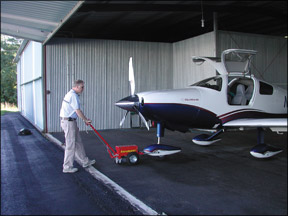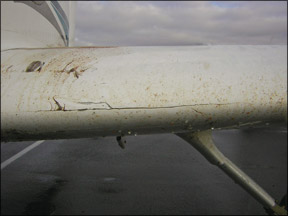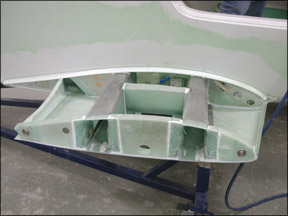Back when fiberglass airframes were first coming to the piston-single market, one of the sales brochure bullet points was that they would be cheaper to maintain: no corrosion, patching or fill for minor dings, simpler structures with less to inspect on the annual. Unfortunately, thats not what were seeing in the real world. It appears that composite designs, like the Cirrus or Diamond, have traded one set of airframe issues for another and the costs have come out a wash or in favor of metal-at least looking globally. The caveat is important because we saw greater variability in ownership costs within a given design than between designs. The average cost of ownership for two similar-vintage Cirrus SR22s could vary more than comparing an SR22 and a Mooney Ovation of similar model years. That said, some trends emerged and some not-so-obvious gotchas appeared as we looked at peoples actual experiences owning glass airplanes. 
Fixing Broken Glass
By far the most common gripe was the cost of repairing the composites themselves. Cost number one might be just finding someone to do the repair. Any A&P should be able to deal with a dented Piper wing. You may have to fly the plane some distance to find a competent soul to fix your Corvallis-or even to judge what needs to be repaired. Now total the complexity of the job, shop hours, curing time for the repair and travel back to get your airplane to you see how this adds up. If AOG time is an expense for you, youd better add that in, too.
The complexity of composite repair shouldnt be

underestimated. Not all dings are equal, and two small dents that look identical to you might be vastly different beneath the skin. Randy Lambeth, a Cirrus SR22 owner in Atlanta, told us of a dent from an item being dropped on the wing. Hed seen a similar dent on his previous Mooney M20J fixed for $150. The Cirrus fix was over $1000.
Big damage will always cost big money. Steve Blonstein is the chief pilot for the large West Valley Flying Club with three locations around San Francisco. He also leases back an SR22 to the club that happened to strike a goose with its left wing. The only visible damage was a significant crack on the leading edge. The actual repair required the replacement of four square feet of wing and cost $35,000. Even an entire replacement wing (used) for a Cessna 182 wouldnt cost that much.
An important detail here is that part of the repair cost was paying Cirrus Aircraft to design an approved repair. Thats not uncommon with a major composites job. It does mean that Blonsteins repair should drop the cost for the next Cirrus owner who takes out a Branta canadensis.
Thats not to say that all composite repairs are expensive. Blonstein pointed out that touch-ups to the Cirrus paint were easy and cheap. We also noted in our December 2009 report on painting composite aircraft that some designs had thick enough top coats at the factory (particularly Diamond aircraft) that dull paint could be polished back to a new-looking shine.
Full repaint jobs for composite aircraft use 10- to 25-percent more labor on prep due to the care and limitations of removing the old paint before painting, but the taping and painting itself can be simpler and cheaper, so our December 2009 report found the total job not that much more expensive that comparable metal jobs.
Since West Valley operates several Cirri in a busy rental environment, we asked Blonstein how the fiberglass airplanes fared overall compared to the metal aircraft on the flight line beside them. Exact comparisons were difficult because all West Valley aircraft are leasebacks and maintenance varies at the discretion of the owner, but he felt that overall, they were a wash. He did note that repairing cracked wheel pants and replacing the vinyl striping on the Cirrus is an above-average cost that crops up often. He added, however, that most maintenance differences have smoothed out in recent years as what were new systems have been revised and redesigned.
We heard this echoed by several Cirrus owners. Still, the average annuals reported by the Cirrus owners we talked to came in $2000-$3000 higher than like-vintage Cessna 182s. However, getting Cirrus-like performance in metal would require something like a Mooney, which has the added expense of maintaining the retractable gear.
No Corrosion? Not
One savings in composite aircraft should be that corrosion is a

non-issue. That pays off in an absence of repairs to a corroded airframe, as we’ll as skipping the $1000 or so every four years to reapply corrosion proofing if you live near the sea.
But its not that simple. While the composite might not corrode, hinges, bell cranks and other hardware are still susceptible. Jeff Soules of U.S. Aviation picked up a Florida-based Diamond DA40 to bring back to his Texas flight school that operates several Diamonds. The detailed inspection turned up 51 squawks on this relatively new aircraft. Many were corrosion related, including corrosion inside the wing where screws carried moisture to the lightning-protection mesh and broke the required electrical continuity. Total cost for all the repairs: $29,000.
The wing corrosion was discovered because the DA40 had 1000 hours on it and was due for the mandatory 1000-hour structural inspection that involves removing the wings. Missed the memo on that inspection? Its less daunting than you might think, due to the design of the Diamond, but Soules estimates it costs $2500 for the labor alone. Hes found this same mesh corrosion issue on other inspections that have doubled the cost of the job.
An analogous “surprise” cost for some Cirrus owners is the parachute repack that must be done every 10 years. For older Cirrus aircraft built without an access panel for the parachute, this maintenance could cost over $9000. We also found in our research that leaking rear windows seems to be a common issue cropping up now in the Cirrus fleet.

Soules says the annuals on his Diamonds (DA20s, DA40s and DA42s) are cheaper than comparable Cessna 152s, Cessna 172s and Piper Senecas in his fleet, but that the minor savings is lost to the wing inspections, and that overall maintenance costs for at least the piston singles are close to equal. We find his an interesting perspective because hes operating seven Diamonds, 23 Cessnas and six Pipers logging a combined 3000 to 4000 hours a month in the same training environment and using the same maintenance program.
Soules believes that a private owner of a composite aircraft would actually fare better because some of the expensive repairs are a direct result of the rigors of a training environment.
Cant get at the parts
Checking with shops, we found that avionics and interior work can be an issue with some of the fiberglass designs. They usually have fewer inspection panels and interiors are often built with more single-piece assemblies, such as a one-piece headliner. One shop told us that getting to a remote system such as a bad flux gate (digital compass) or pulling the interior to add a new antenna (say, for a WAAS upgrade) can take twice the labor of a comparable metal aircraft. But that varies widely with what needs to be accessed in what airframe.
Adding antennas to any fiberglass aircraft can be tricky, but manufacturers and shops seem to have built the skill that this

is less of an issue than it used to be. On the plus side, the fiberglass aircraft often ship from the factory with most every gadget you could want. It will be interesting to see if ADS-B upgrades are generally more expensive for fiberglass designs than for metal ones.
Upgrades sometimes introduce unexpected consequences. Perhaps the most notable one was the electric de-ice STC for Columbias that turned out to be a fire hazard, but only after several owners paid to have them installed.
An issue that seems to be getting better with time is parts availability. Mechanics used to being able to get any part, any time for a Cessna had been frustrated with how long it could take to get a part from some of the newer companies. We see the same thing happening now with new LSA companies and think its endemic of young companies rather than the newer aircraft designs.
Still Worth It?
Jeff Harris told us, “I owned a 1978 182 for almost three years and sold it to buy a new Cirrus back in November of 2002 so I wouldnt have to worry about ongoing maintenance issues. Boy, was I in for a shock and an expensive education.” The next four years of bills and maintenance frustrations almost led him to selling the airplane. Why didnt he sell it?
“I love my Cirrus when it works,” he told us. “For the last couple of years it has been a champ. All I want is a dependable aircraft that I can maintain and does what its supposed to do. After four years of squawks it seems to be doing that.”
Its hard to find the combination of performance, interior space and sophisticated systems you get in a Cirrus or a Corvallis in anything built using aluminum. Owners wanting that triumvirate are willing to put up with some level of additional maintenance load to get it.
How much of an additional load it is, we don’t have enough data to say. Collecting a big enough sample of aircraft operated and maintained to the same standards is tough. And there are no 10,000-hour composite airframes to tell us what the super-long-term viability is going to be. We also recognize that our results may be skewed by the early learning curve the industry has weathered in creating both the composite designs and the expensive systems inside them.
We wouldnt shy away from any of the composite aircraft strictly because of a potential for higher maintenance costs. What is clear, however, is that anyone expecting some relief from the maintenance burden by buying a fiberglass design-or, perhaps, even just a new airplane-is in for a harsh disappointment.


